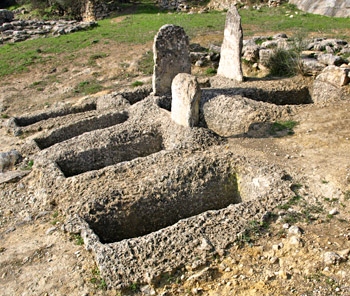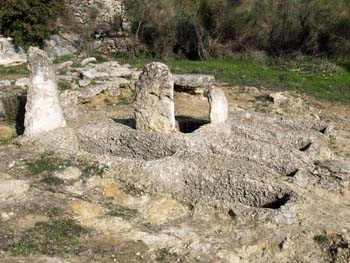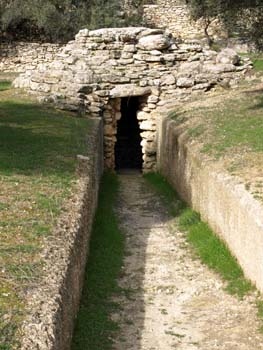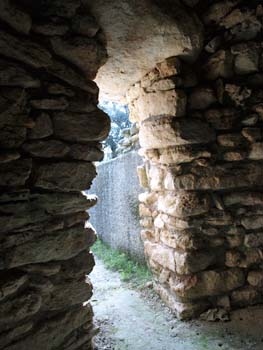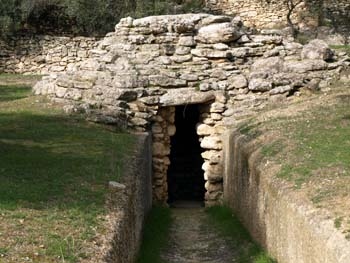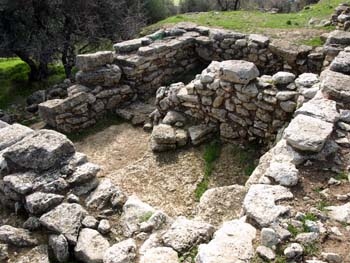Phourni
1,000 years of burials
The Minoan cemetery at Phourni is one of the most important sites in Crete and certainly the most important Minoan cemetery to be uncovered to date. Its importance is largely due to the fact that it remained in use for over 1,000 years from the EM II period (around 2400 BCE) to the LM IIIC period (about 1200 BCE) when the Minoan period was all but over.
It is also important because undisturbed burials of two women were discovered here. The two women were almost certainly of royal birth and they lived during the Late Minoan period after the final fall of Knossos and during a period when the Mycenaeans had come to dominate life on Crete.
The cemetery is located on the top of a small hill called Phourni -- the name originates from the Greek word for oven. From the hill there are spectacular views of the plain on which the town of Archanes now stands and where a Minoan palace once stood. On the other side of the hill, separated by a ravine, stands Mount Iuktas, with its peak sanctuary.
Mycenaean Grave Enclosure
Starting at the north end of the cemetery we find a Mycenaean Grave Enclosure unique in Crete. Most of the enclosure walls have disappeared but the seven grave shafts remain. They were cut into the rock in three rows and a small larnax was placed in each grave. Although the larnakes were empty, numerous funerary offerings were found inside the graves which attested to the importance of the people buried there.
Further evidence of the importance of the burials were the stelai placed above the graves (although they had fallen onto the graves in the distant past). Grave stelai are almost unknown in Crete and are usually associated with Mycenaean Greece. The Mycenaean Grave Enclosure at Phourni brings to mind the Grave Circles A and B at Mycenae where stelai were also placed at the head of certain graves.
It is most likely that the people buried in the Grave Enclosure were members of the Achaean aristocracy based on the island of Crete, although almost nothing is known about how they came to be in Crete and in control of the island.
Tholos Tomb A
A short distance south of the Grave Enclosure we come to Tholos Tomb A, immediately notable for its very long dromos. This was the first building to be discovered at Phourni in 1965 when a stone hut that had always been visible on the surface of the hill was discovered to be the top part of a Tholos Tomb which had been filled up inside with stones over the preceding centuries. The tomb dates from the 14th century BC and has a side chamber in which a royal burial took place.
Interestingly this tholos tomb shares the same ground plan as the two greatest tholos tombs of Mycenaean Greece, the Treasury of Atreus at Mycenae and Minyas at Orchomenos.The lintel of the entrance to the tomb was located at ground level and the tomb below the lintel as well as the dromos had been cut out of the rock. The tholos itself had been comprehensively looted in the past. An unusual find was made however, close to the entrance to the side chamber, when the dismembered corpse of a horse was discovered. A bull's skull was also found and it would seem that both animals had been sacrificed in honour of the person buried in the side chamber.
When the side chamber was excavated a single burial in a clay larnax was discovered. It proved possible to establish the position in which the body had been laid to rest (with the head facing west and the body in a foetal position) and therefore the position on the body of the various small objects, mainly of gold, that were found in the larnax. One of the more important (and beautiful) finds was an amazing gold ring showing a cult scene.
Although the sex of the person buried in the side chamber could not be determined from the skeletal remains, the nature of the funerary offerings showed that the person was without doubt a woman and the richness of the finds imply that she must have belonged to the royal family. The fact that the rings all showed cult and religious scenes suggest that she may have also been a priestess. And this view is supported by the evidence of a bull sacrifice in her honour.
Building 4
This building stood on the eastern side of the cemetery between Tholos Tombs A and B. This building, like so many on the site, is unique not only in Minoan Crete but also in Aegean Bronze Age cemeteries. The building was used to care for the dead and was in use during the LM IA period (1550-1500 BCE). The building is divided into two wings.
The East wing is on a higher level than the west wing and had an upper storey which once contained at least one loom, as attested by the presence of 46 loom weights which had fallen into the rooms below during the catastrophe that destroyed the building. Other finds, including knives, a cutter, a lead weight from a pair of scales and a piece of bronze ready for working on all suggest that the upper storey was entirely devoted to manufacturing. On the ground floor, room 1 may have been used to store the must from which wine is made because room 2 was used as a wine press.
The west wing was built on higher ground, on top of the rock, and was not separated into individual rooms. The bases of three columns were found in this area and one possible interpretation is that the area was in fact a paved area, open along its western side. It could then have been used as a place where funeral rites were performed. Finds taken from the site would support this view as they included the remains of a libation table, fragments of two bell-shaped figurines and about 250 cups placed either upright or upside-down, and these are known to have had some sort of ritual significance.
It would seem, then that the building was used for making things that would be used in looking after the dead. The only other place where such buildings exist is in Egypt, where the manufacture was under the control of the priests. This may well have been the case, too, at Phourni.

